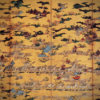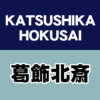Watanabe Seitei: An Authority on Bird-and-flower Paintings, Fusing ‘Iki’ or Chic, the Aesthetics of Edokko, and Western-Style Paintings
Cotton Roses and a Varied Tit
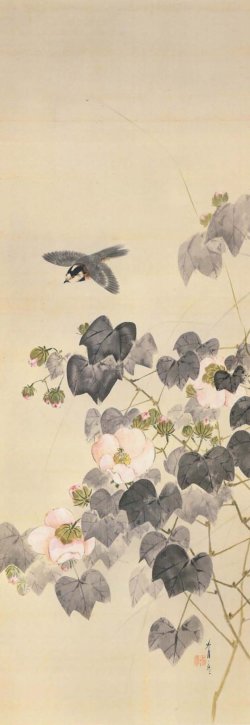
Watanabe Seitei was born in Edo (present Tōkyō) in 1852. Though he, as a disciple of Kikuchi Yōsai, had learned painting skills for several years since he turned 10 years old, he had drawn few historical paintings. Later recognized by Matsuo Gisuke, the president of ‘Kiritsukōshō Gaisya’, an exporter of arts and crafts, founded in 1874, Seitei had worked as a craft designer at the company. He was awarded the ‘Kamon shō’ prize in the first Naikoku Kangyō Hakurankai exhibition in 1877. In the next year when he won a prize in the Paris World Exposition, taking the opportunity of this achievement he went to France, traveling around for several years to study Western-style paintings, thereby breaking a new ground for bird-and-flower paintings. After he came back to Japan, he received the ‘Myōgi santōshō’ prize in the second Naikoku Kangyō Hakurankai exhibition in 1881. He had also sent his works to the Amsterdam World Exposition in 1883 and the World’s Columbian Exposition held in Chicago in 1893. In later years of his life, however, he had distanced himself from the art world and never sent his works to any of public exhibitions. He died in 1918.
While Seitei had learned painting techniques under Kikuchi Yōsai who was skilled at historical paintings of Yamato-e, he had adored Shibata Zeshin. He had not drawn any of figure or historical paintings, rather labeled himself as a bird-and-flower painter. Behind this lies the assumption that he had learned Zeshin’s Shijō painting style by himself. The bird-and-flower paintings drawn by Seitei convey the vividness which is lacking in the works drawn by other painters in Edo, as well as even the aspect of clarity he had acquired through the Western-style paintings. He had developed a new world of a mixture of the traditional techniques of Japanese-style paintings and modern people’s eyes.
This painting depicts just one scene of nature – one varied tit flying by a bunch of cotton roses. This is quite a fine work with the depiction of cotton roses enabling us to feel a kind of a refreshing modern touch.
Cherry Blossoms with Sparrows / The Moon with Plovers / Autumn Leaves with Small Birds
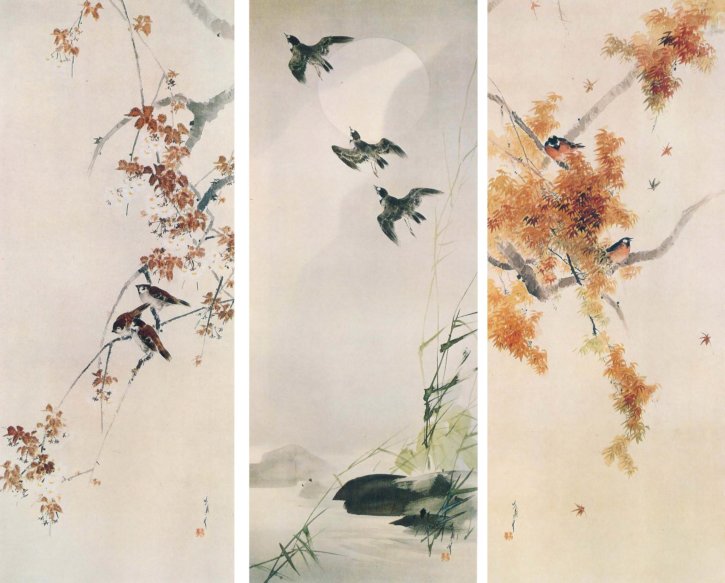
Seitei drew an illustration for ‘Kochō’ (Kochō is the name of the leading character), a historical novel written by Yamada Bimyō, published in ‘Kokumin-no-tomo’, a monthly magazine in 1889. The illustration which drew the nudity of a 17-year-old beautiful girl got tremendous attentions in those days, resulting in ‘the nude painting dispute’. This dispute preceded the so-called ‘the Chōshō Controversy’- ‘Chōshō (Makeup in the Morning)’ is a painting drawn by Kuroda Seiki. ‘The Kochō dispute’ must be hardly discussed without taking account of the world where Seitei had learned the western-style paintings. For Seitei who went to France ahead of other Japanese painters, the naked lady was just one of painting subjects and was not the taboo subject at all. This kind of the Western sense he had acquired is not only limited to the subject issue but also found in his bird-and-flower paintings in essence. Good examples are the Western-style painting techniques seen in some of his works such as the rough sketches of the Akasaka Palace (current State Guest House) and ‘Fowls in the Snow’, one of Seitei’s masterpieces, which was sent to the World’s Columbian Exposition held in Chicago in 1893.
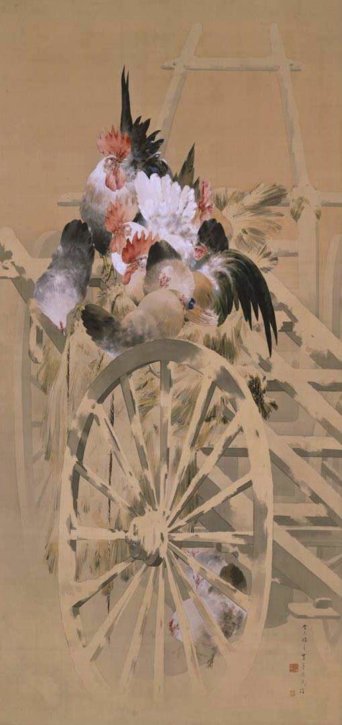
The depiction of objects with the gradations of color was the pioneering attempt in the new trend of the modern Japanese-style paintings by Seitei, even ahead of Takeuchi Seihō. His style seemingly has a kind of traits like those of Kishi Chikudō, a painter in Kyōto.
These paintings depict flowers and birds of three seasons, spring, summer, and autumn respectively: cherry blossoms with sparrows, the moon with plovers, and autumn leaves with small birds. Any of techniques in the depiction of the twigs/branches of cherry blossoms, in the brushworks of reeds and banks, or in the exquisite touches of autumn branches and leaves, have never been used in the traditional Japanese-style paintings. In particular, the brushworks of reeds and banks in ’The Moon with Plovers’, reminding us of the touch of Western-style paintings, remarkably shows the excellent features of the Western-style paintings which Seitei had acquired.
Cranes on a Pine Tree / Quails in Withered Fields
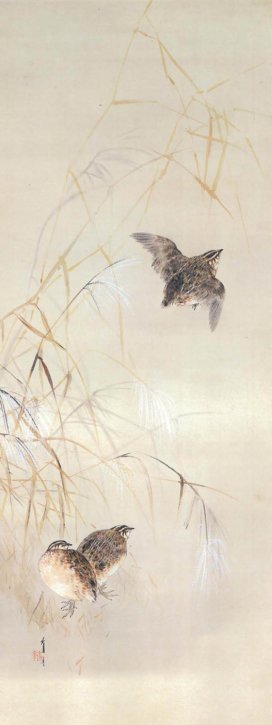
‘Cranes on a Pine Tree’ depicts two cranes standing on the thick trunk of a pine tree drawn in the center of the painting. This work is quite distinctive among Seitei’s paintings, since the composition is extraordinarily unusual. This work is still one of refined bird-and-flower paintings drawn by Seitei, a true-born Edokko or Tokyoites, but with slight difference in taste. It is extremely interesting for Seitei to be equipped with such an aspect, which deserves our attention.
‘Quails in Withered fields’ depicts two quails standing still at the bases of withering reeds beside a pond and another quail just flying away, giving us somewhat a lonely and quiet impression. The rhythmical movement of the withering reeds’ leaves and ears is skillfully depicted, in which Seitei’s original chic world is also unfolding here.
Bird-and-Flower Paintings

Watanabe Seitei must have been one of the Japanese-style painters to visit Europe quite earlier than others. To learn the Western-style paintings some had already visited Europe at the beginning year of the Meiji period. We, however, wonder how many Japanese-style painters had already been to France by that time. Under such circumstances, Seitei, right ahead of other Japanese-style painters, had visited Paris, having the opportunity to gain firsthand experience of the Western cultures and the French arts, thereby absorbing them. The time Seitei had visited Europe was right after the 1st, 2nd, and 3rd Impressionist exhibitions were held, when a new wave of art has just started at last in Paris. It was really the dawn of new art era in Paris, too, with the impressionist painters like Édouard Manet, Claude Monet, Pierre-Auguste Renoir, and others making their splendid debuts. To Seitei’s eyes must have been developed an astonishing world which he had never imagined in Japan. He must have visited the Louvre Museum to feel the essence of the Western art and may also have had the opportunity to appreciate the impressionists’ works. His experience in France undoubtedly had given a tremendous impact on him.
As for his upbringing, Seitei was a true-born ‘Edokko’, living in Nihonbashihama-chō. Seitei’s works had been seemingly favored mainly by people living in Japanese traditional old towns. It has been said that he had loved arts for amusement and often had made his way to a Japanese-style restaurant in the Daichigashi area – the riverside area of Sumida-gawa River. These Edokko’s ‘Iki’ or chic and his experience in Paris interactively had given rise to the refined and graceful Seitei’s world of bird-and-flower paintings.
This work is a pair of six-panel folding screens, a valuable work as a well-organized art, since Seitei had drawn few big pieces. Each of 12 panels is quite elegant, with each kind of seasonal bird drawn together with corresponding each seasonal flower. What is drawn on 12 panels respectively is from the right, a bird on a withering willow, a sparrow on a plum tree, skylarks with wheats, a small bird on a cherry blossom tree, a butterfly with a peony tree, egrets with willows in the rain as for the right 6 panels, and a wagtail with lotuses, carps with the moon, a small bird with chrysanthemums, a pigeon on a branch, seabirds on rocks, a bird on a heavenly bamboo tree as for the left 6 panels. Only a pair of these folding screens thoroughly expressing the Seitei’s world is more than enough for us to enjoy his world.
Winter Chrysanthemums/ A Crow at Dawn/ Rooster and Hen
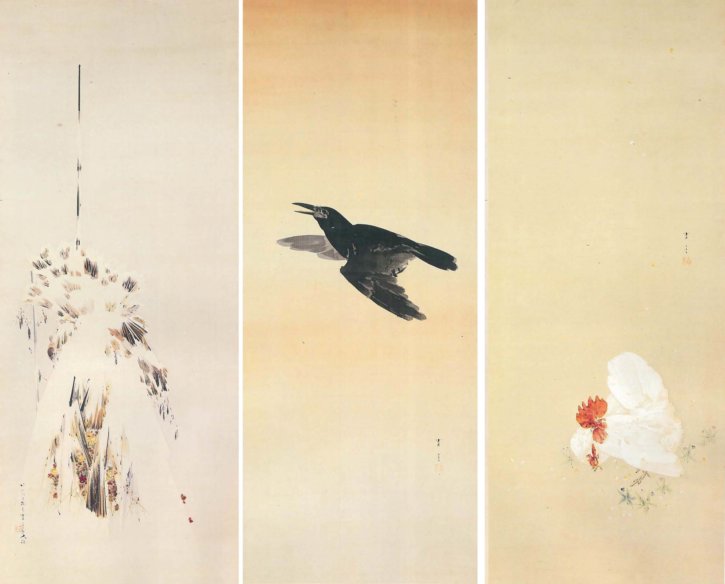
A Pigeon with a Pine Tree / Pigeons with Falling Autumn Leaves
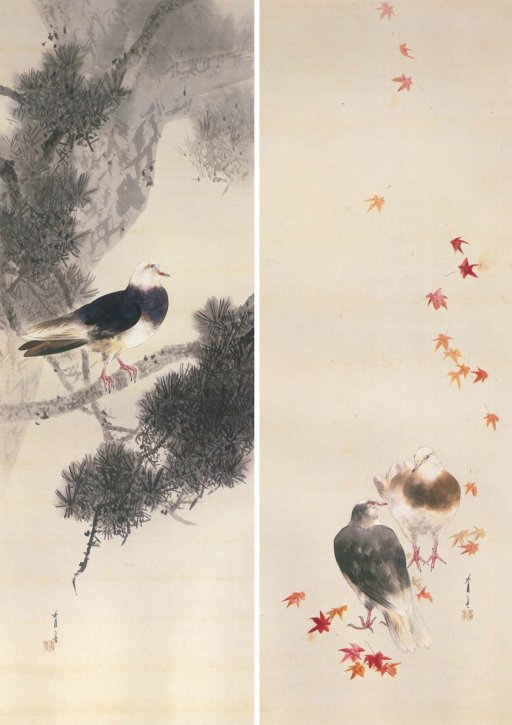
Watanabe Seitei, an Edokko born and bred, since his age of around 15 had learned painting techniques under Kikuchi Yōsai, active at the end of the Edo period, an authority of Yamato-e paintings. Seitei, however, had not opted for the world of the historical and genre paintings which Yōsai, his master, was skilled at, and had rather drawn bird-and-flower paintings. This means Seitei, acclaimed in later years as an authority of bird-and-flower paintings, had already determined the course of his life as early as his boyhood. Seitei, a true-born Edokko, had continued to live in Nihonbashihama-chō. He had been said to love ‘Fukagawa-tei’, a Japanese-style restaurant in the Daichigashi area, enjoying arts for amusement frequently. On the Paris World Exposition, Seitei, a chic Edokko painter, visited Europe to study, traveling mainly around Paris in the later years of the 1870s and other regions in Europe and came back with plenty of knowledge about the western arts he had gained in person. The Paris art world in which the impressionist painters had just started to attract people’s attention with the death of a great master, Gustave Courbet, was reaching a turning point in history. Seitei had directly seen and felt the atmosphere of the Paris art world at the time when Romanticism and Classicism had still made their presence felt. He as a chic Edokko must have strongly sympathized with the chic brilliance in Paris. Tokyo at that time ushering in the Meiji period had tried to take in the Western cultures promptly, being baptized by so-called the ’Modernization’ movement. For Seitei who had grown up under such circumstances, the European culture he had felt at first hand must have been a great stimulus. The stimulus, befitting with the mind of Edokko, had helped fuse inside Seitei the Edo culture and the modern paintings in Paris, resulting in his unique, fresh, and refined artworks. It is quite easy to name quite a few painters other than Seitei regarding the works expressing the Edokko’s ‘Iki’ or chic only. The original world of Seitei had flourished only when the element of the Modern France was added. ‘Winter Chrysanthemums/ A Crow at Dawn/ Rooster and Hen’, a set of three hanging scrolls, is the best work representing Seitei’s graceful and snappy world.
‘Rooster and Hen’ depicts a pair of big and white fowls with red comb in bold brush stroke of whitewash using the tsuketake technique. Pretty violet blooms at the foot of fowls, surrounded by scattered cherry blossom petals. Fluttering petals in the air cover only a limited part of a broad space. The composition is quite simple and clear – a pair of white fowls are drawn in the lower part of a vertically long screen. With the contrasting color of white and red – the white bold touch using whitewash and red combs – superbly outstanding, Seitei’s sentiment as an Edokko is impressively well-expressed.
‘A Crow at Dawn’ depicts one crow flying over slightly above the center of the screen with the bold touch of the shade of sumi ink, too.
‘Winter Chrysanthemums’ depicts blooming winter chrysanthemums covered with straw capes – one scene of a corner of a snow-covered garden, recalling one of Seitei’s masterpieces, ‘Fowls in the Snow’. In the depiction of snowy scenery finds his unique atmospheric world, enabling us to sense the clarity, a distinctive feature of the modern people, which is impressive. The composition of three hanging scrolls- the white of fowls on the right, the black of a crow in the middle, and winter chrysanthemums on the left creates the white/black/white contrast, a quite chic combination, which Seitei must have thoroughly considered. He drew this work at the age of 45(It was 2 years after the aforementioned ‘Fowls in the Snow’ was drawn.)- when Seitei was in his prime.
‘Pigeons with falling autumn leaves/A Pigeon with a Pine Tree’, a set of two hanging scrolls depicts a pair of pigeons standing still as if enjoying some talks, surrounded by the red maple leaves falling and flattering. The left screen depicts one pigeon standing on the branch of a pine tree, presenting an interesting contrast in high and low balance. The pigeon on the tree seems to be looking down the two pigeons on the ground. In the depiction of pigeons is found a realistic modern sense. The expression of the trunk or branches of the pain tree with the mokkotsu technique also has carved a clear path in the transitional phase of the modern Japanese-style paintings from the Edo to the Meiji period.




